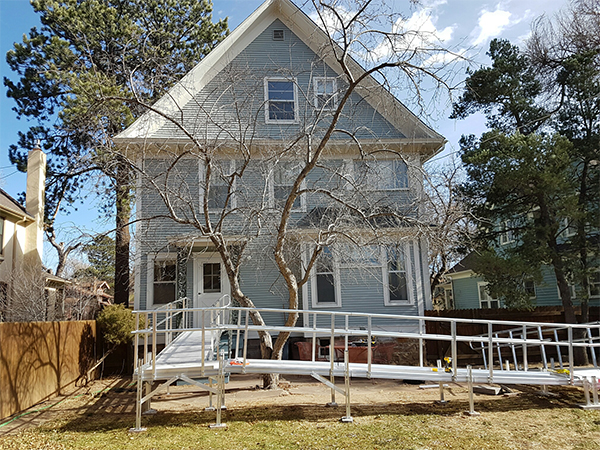
For seniors, being able to live independently at home remains a common choice. According to a report from Harvard University’s Joint Center for Housing Studies, the vast majority of adults 65 years and older live in detached, single family housing. If you are part of this population, you are nearly as likely to live alone as with a spouse, child, or other family member. Put another way, 50% of seniors live at home alone.
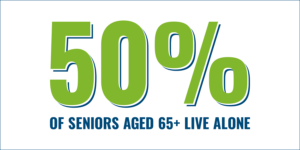
Whatever your living situation at home looks like, you should know the vital importance of a strong support system. Many studies show that strong interpersonal and social connections benefit nearly every dimension of a senior’s life, including:
- Physical function
- Mental health
- Life satisfaction
- Managing chronic conditions
- Navigating stress
- Recovering from injury or illness
- Longevity
The truth is, you’ll have better chances of long-term success if you stay informed and prepared. This article is part of a series focused on living independently as an older adult–also called “staying in place” or “aging in place.” Part 1 covered tips to prepare yourself and your home.
Welcome to Part 2!
This article is Part 2 in the series, and covers 4 MORE tips for seniors who want to live at home–with a focus on strengthening your support system:
- Learn the benefits of belonging
- Use technology to connect
- Make primary care a habit
- Record your preferences
We hope this series is a helpful resource for you. Please note that these articles are intended for informational purposes only and should not substitute medical advice. If you have health-related questions or concerns about living at home, we recommend you consult with your medical provider.
Our expertise is focused on accessibility solutions for your home. Contact your local accessibility experts at Next Day Access for a FREE in-home consultation. We’ll conduct a safety assessment and offer recommendations based on years of experience and thousands of happy customers served.
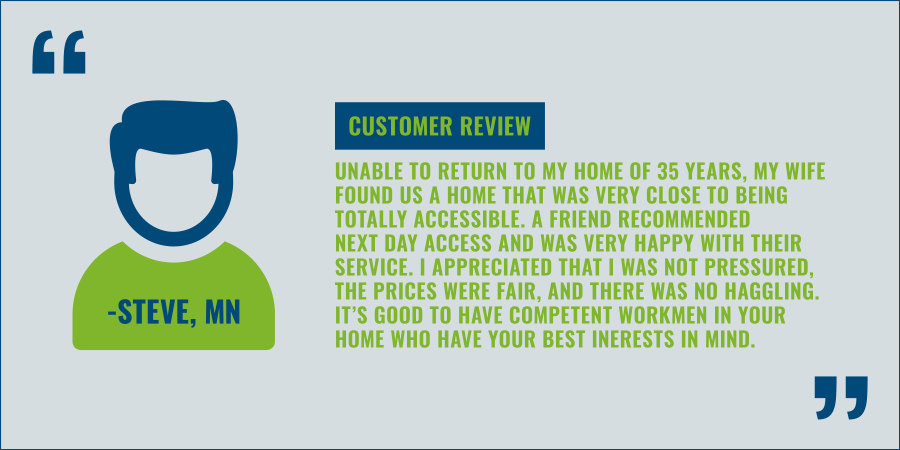
1. Learn the benefits of belonging.
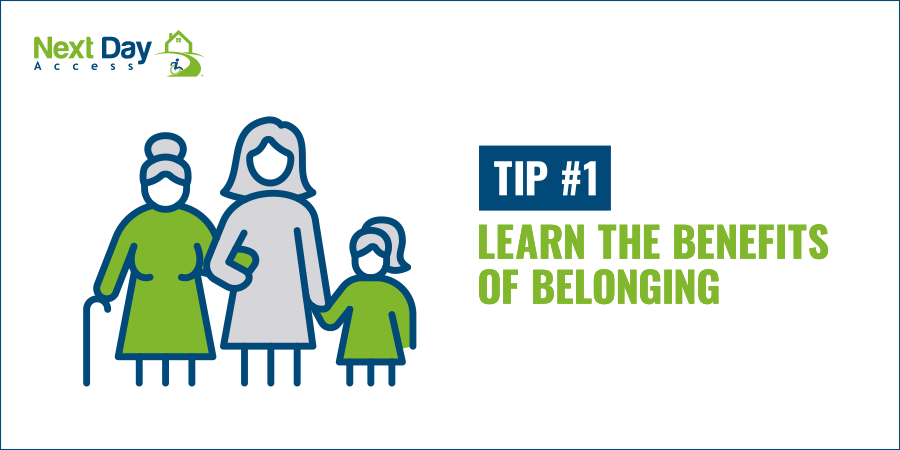
There are many reasons why staying in place is the most common choice for seniors. Perhaps you’ve lived in your home for decades and want to stay where your favorite memories were made. Maybe you feel more comfortable living in a familiar house and neighborhood. Or maybe you downsized recently and want life to continue as normally as possible, for as long as possible.
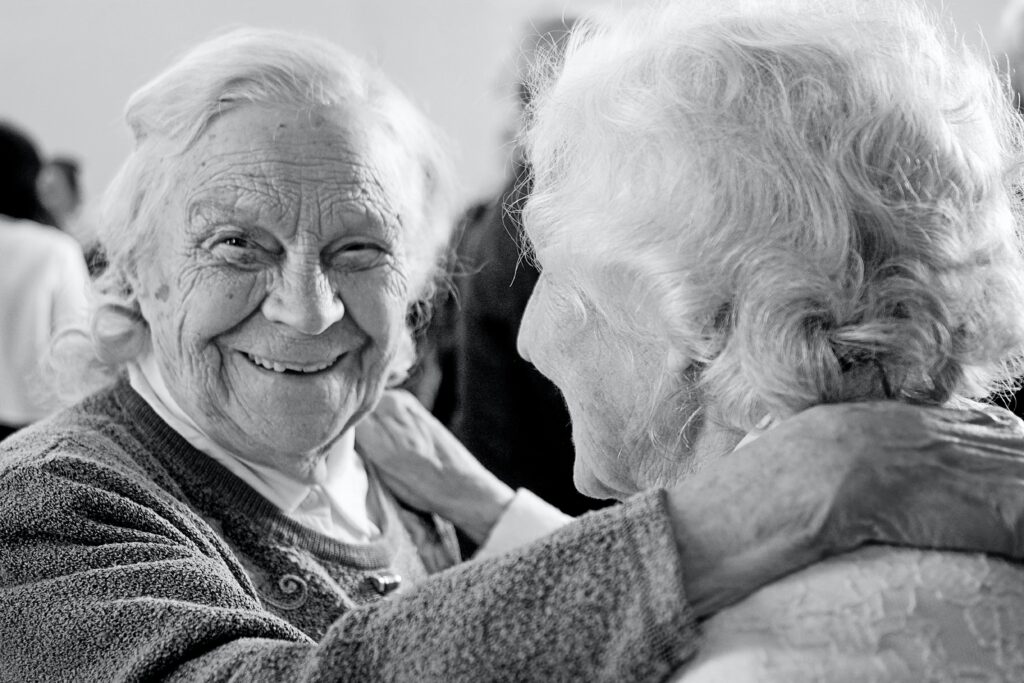
Whatever your reasons, a major advantage of being able to live independently at home is keeping your connections with friends, family, and neighbors. Social connections provide strong protections for seniors who live at home including:
- Less loneliness
- Higher quality of life
- Better outcomes
For example, a recent study published in Frontiers in Psychology found that loneliness contributed strongly toward higher depression rates and lower self-ratings of health in older adults. The report associates loneliness with social isolation as a result of “having a smaller social network, more functional limitations, and limitations in engaging meaningful activities.”
Another report published in American Psychologist describes the health benefits of social integration for seniors, including “reduced risks for infectious illness, cardiovascular disease, overall cognitive and physical decline, and both cancer-specific and overall mortality.”
At the same time, loneliness is a serious issue for older adults in the U.S. Polling data from the University of Michigan shows that 1 in 3 adults between 50 and 80 years old experience isolation. Loneliness rates have doubled since the 1980s, resulting in serious, widespread effects on public health–enough for former U.S. Surgeon General Vivek Murthy to identify loneliness as an “epidemic.”
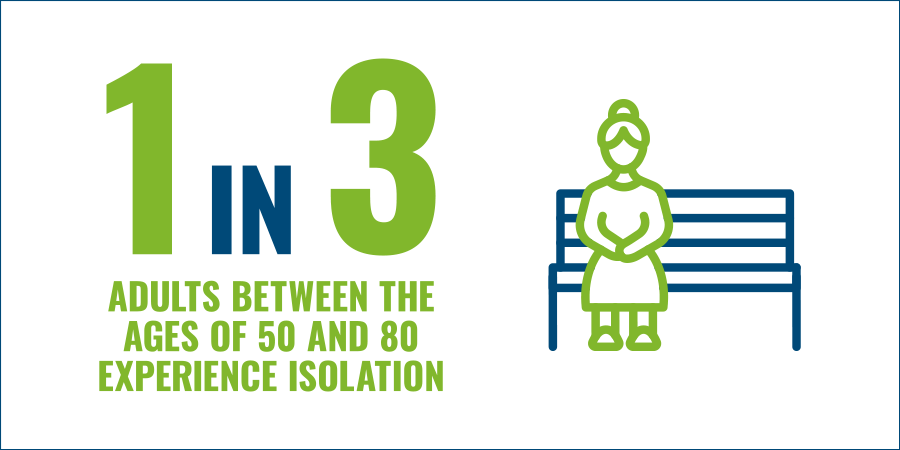
Strenthen Your Connections.
If you want to strengthen your social connections, check out resources from the Administration for Community Living or consider the following:
- The Friendship Line is a phone “warm” line operated by staff and volunteers from the Institute on Aging. The line offers a variety of services including well-being telephone check-ins, grief counseling, bereavement support, home visits, and crisis intervention.
- The AARP Virtual Community Center offers free online events and classes for “education, self-improvement, and fun.”
- The Senior Center Directory can help you locate the nearest senior center to your home. Senior centers are a great place to meet people in-person and get involved in activities, classes, volunteering, and other programs. Many centers also facilitate counseling, support groups, meals, transportation, and other social services.
If your social life is limited by accessibility issues, please reach out to us. Your local accessibility experts at Next Day Access can work with you to find solutions based on your unique needs.
“Competitively priced, quality materials, and professional installation: what more can one ask for? The ramp is super and it enables my Mum to safely come and go from her home. Many thanks! Best in class client service and work.”
Paula, Toronto
2. Use technology to connect.
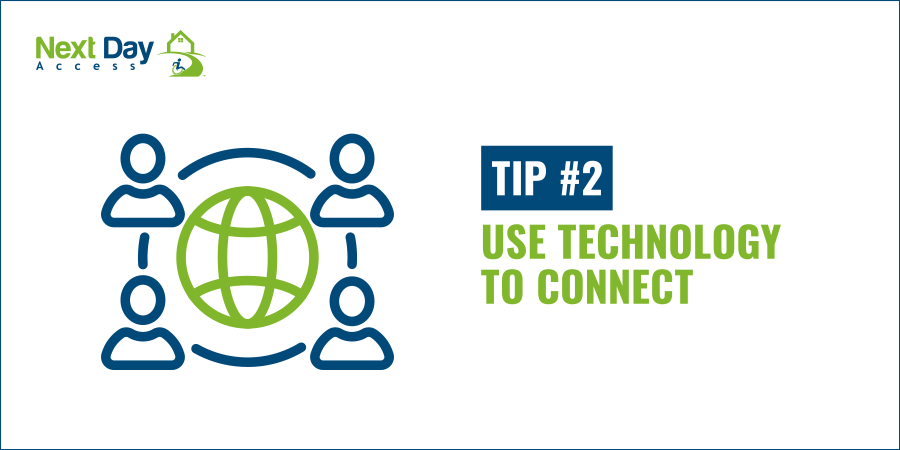
Recent developments in technology have revolutionized life for older adults. From the comfort of home you can visit with friends and family, attend medical appointments, schedule transportation–the possibilities are almost endless. As the U.S. population ages, technology is being adapted specifically for use by older adults.
You can use smart technology in your home for security, smoke alarms, lighting, appliance monitoring–even alerts when your milk expires! Both in and out of your home, technology can also be a powerful tool to connect you with your support system.
Below are some innovations that keep you safe and connected while you live independently at home:

Smart monitoring.
In Part 1 we introduced Smart Alert Tech plugs and sensors that protect your privacy while monitoring your safety. You can also use smart plugs to improve safety in other ways. For instance, you can set a timer and stop worrying that you’ve forgotten to turn off your space heater. Or you can pair your smart plug with an app on your mobile device to control lights remotely–reducing the risk of losing your balance or tripping in the dark.
Online technology training.
Most people know about technology like smartphones, social media, and video calls by now. According to surveys by Pew Research Center and MetaFacts, a growing number of adults 65 years and older use these technologies to stay connected, engaged, and informed:
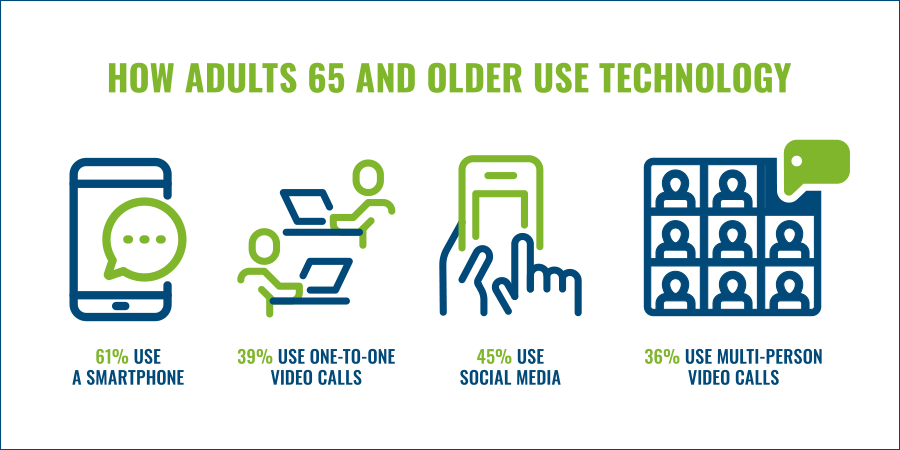
- 61% use a smartphone
- 45% use social media
- 39% use one-to-one video calls
- 36% use multi-person video calls/conferences
Even so, many seniors have questions about how to use technology. You might have questions about the basics, or want to know which platforms are best to connect with others. Or you might want to know how to protect yourself while using online technology.
You can find support for your questions by reaching out to organizations like Cyber-Seniors. Cyber-Seniors is a nonprofit organization that pairs seniors with volunteer technology trainers who can help you learn a wide range of skills. Below are a few recent webinars that share how you can use technology to connect with others:
Another option is Senior Planet, a nonprofit organization founded by AARP and Older Adults Technology Services (OATS). Senior Planet describes their purpose as helping “older adults to come together and find ways to learn, work, create, exercise, and thrive in today’s digital age.”
The organization’s technology training focuses on five “impact areas”: financial security, social engagement, creative expression, health and wellness, and civic participation. Check out Senior Planet’s free online offerings including:
Telehealth.
Since the COVID-19 pandemic, remote technology has become an increasingly popular option to access physical and mental health care. Depending on the services you access virtually, you might hear the terms “telemedicine,” “telehealth,” “virtual care,” or “e-visits” when getting healthcare online.
While each of these terms has a slightly different meaning, they can all be considered forms of telehealth. The Health Resources and Services Administration defines telehealth as “the use of electronic information and telecommunication technologies to support long-distance clinical health care, patient and professional health-related education, health administration, and public health.”
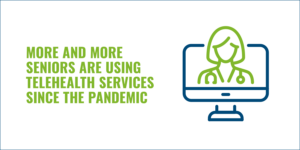
Like other demographics, older adults are using telehealth more since 2020. According to a recent research from AARP, 50% of adults aged 50 and older reported they or someone in their family has attended telehealth appointments within the past two years.
Survey respondents reported a variety of reasons for using telehealth including:
- Regular doctor’s visits
- Prescription renewals
- Talking about new medical issues
- Diagnosing illnesses
- Getting care for a family member
If you have questions about using telehealth as an older adult, the U.S. Department of Health and Human Services has online resources that you may find helpful. You may also find support by contacting your medical provider or local senior center.
Of course, technology can help you stay connected both inside and out of the home. Contact your local accessibility experts at Next Day Access for more information on technology that keeps you safe, connected, and empowered while on-the-go.
“The entire process was much quicker than we had hoped for and the work was exemplary. All of the individuals involved in the process are in A+.”
Keith, California
3. Make primary care a habit when you live independently at home.
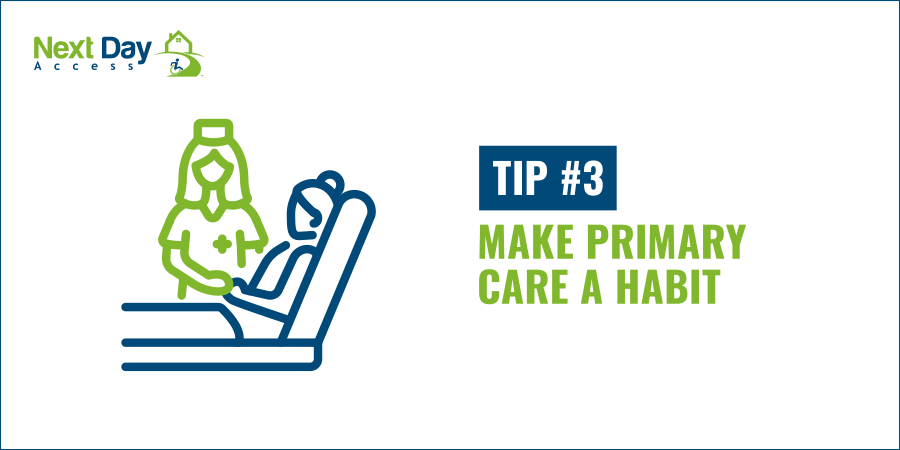
You can maintain relationships with doctors you trust.
You can also improve your chances of staying safe and healthy when you live independently at home by actively partnering with your doctor to build continuity of care. Continuity of care is defined as consistent healthcare services that are appropriate to your needs over time.
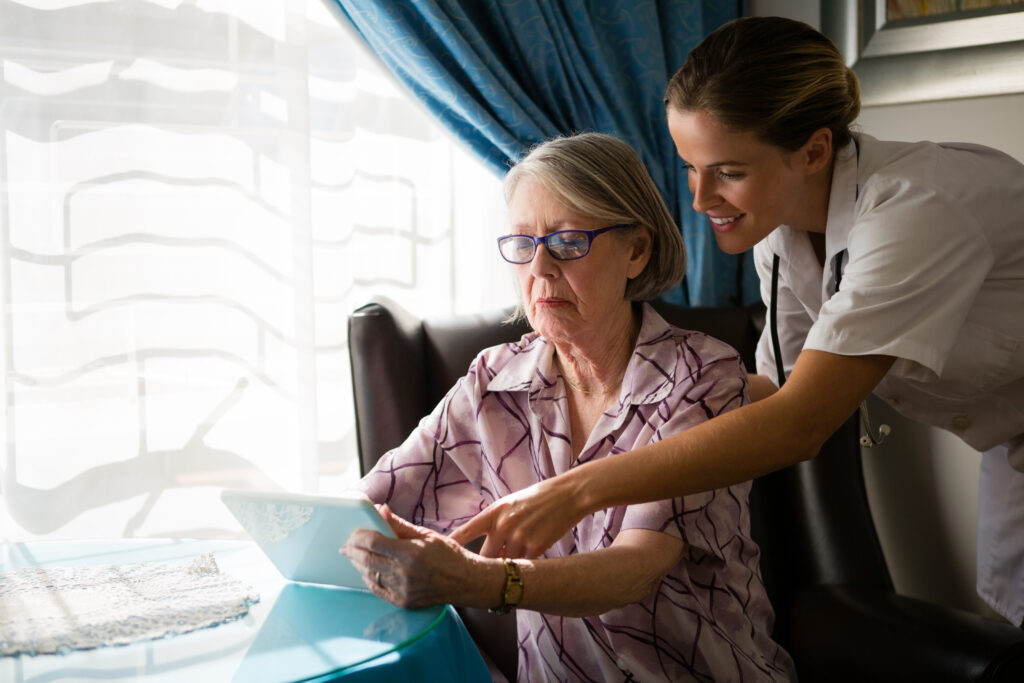
Primary care serves as one of the most important components of continuity. Consider findings from recent research published in Scientifica about the benefits for seniors who receive primary care:
- Less healthcare costs
- Reduced risk of hospitalization
- Improved health outcomes
- Lower morbidity
By seeing a primary care provider regularly, you can access an array of beneficial services including preventative care, early detection, and management of chronic diseases.
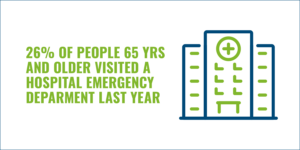
Plus, your primary care physician can effectively coordinate with specialists or other providers if you need support from another department or facility. Consider this: a recent Profile of Older Americans survey reports that 26% of people 65 years and older visited a hospital emergency department in the past year.
With emergency room visits more common amongst seniors, having continuity of care can make an important difference when the unexpected happens. By building a good relationship with your doctor, you’ll have better support from a professional who knows your medical history, needs, and preferences.
If you need safe, reliable access to in-person medical appointments, Nous contacter. Your local accessibility experts at Next Day Access can meet you at home and hear about your accessibility needs. We’ll work with you to find a solution that fits your specific situation.
“I have Rheumatoid Arthritis and Parkinson’s Disease, with severe mobility issues. Next Day Access was extremely flexible: on the day of installation, they showed up on time…the installers were professional, courteous, and knowledgeable. They took the time to answer all my questions, were in and out of here in no time, and the job was completed in a very timely manner. Would recommend them to anyone needing this type of help with access around your home, and for those with loved ones who need the freedom of mobility that this provides.”
Monty, Colorado
4. Maintain physical accessibility outside of your home.
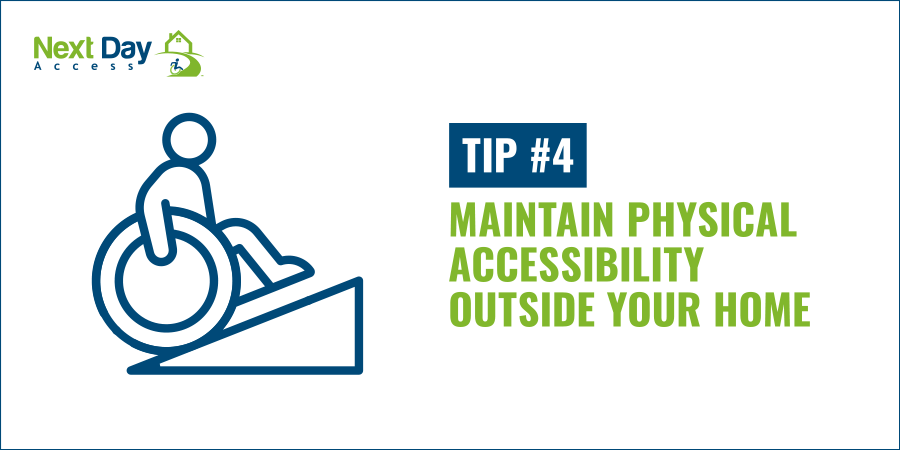
Many older adults experience mobility limitations–and barriers when they live independently at home.
If you choose to live independently at home, you can make a big difference in your quality of life by ensuring physical accessibility outside of your home–also known as “outdoor mobility.” In the context of outdoor mobility, physical accessibility involves removing barriers that would others reduce or prohibit your movement outside of the home to access things like:
- Goods and services
- Employment opportunities
- State and local programs
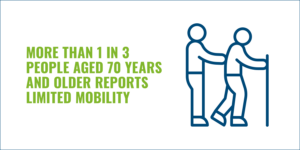
According to research published in Frontiers of Physiology, more than 1 in 3 people aged 70 years and older reports limited mobility.
You might have a mobility limitation, impairment, or disability related to any one or more of the following:
- Muscle weakness or stiffness
- Weight concerns
- History of falls or balance issues
- Injuries
- Surgeries
- Chronic health conditions
- Weight concerns
Additional studies from The International Journal of Environmental Research and Public Health underscores the importance of outdoor mobility for older adults’ health and wellbeing. Researchers say that mobility “goes beyond accessibility” in affecting people’s sense of “independence, control, status retention, integration, and ‘normalcy.’” Outdoor mobility is a big deal!
Even with federal civil rights protections like the Americans with Disabilities Act (ADA), many people face barriers based on mobility limitations, impairments, or disabilities–particularly older adults.
Researchers identified the following common barriers to outdoor mobility for older adults:
- Lack of accessible transportation alternatives
- Environmental factors like hills, stairs, and available parking
- Sense of isolation while living alone
- Extreme weather conditions
There are health risks associated with limited outdoor mobility.
Seniors who face barriers to outdoor mobility may be at risk of a status known as “homebound.” Homebound status is defined by researchers at Mount Sinai as leaving the home once per week or less. Research shows that homebound adults may face worse outcomes in physical, mental, or social health, as well and increased mortality rates.
Since the beginning of the COVID-19 pandemic, the prevalence of homebound adults has risen significantly. According to recent research published in JAMA Internal Medicine, the number of U.S. adults who qualify as homebound has more than doubled since 2020.
Research published in BMC Geriartric identifies potential factors associated with an increased risk of being homebound including:
- Older adults
- Females
- Mobility device users
- Anyone with dementia
- Those with prior history of falls
- People living with anxiety or depression
- Individuals experiencing social isolation
As you can see, some of the above risk factors cannot be changed. However, many of the factors above can be mitigated by removing barriers and restoring outdoor mobility.
You can get professional support right away by contacting your local accessibility experts at Next Day Access. We’ll schedule a free in-home consultation that simplifies your process, identifies barriers, and offers relevant solutions.
“Next Day Access has been exceptional in every part of the process. From my first inquiry, all questions along the way to the final installment. Their prices and warranty are very competitive, but most importantly to me I have confidence in their service and professionalism. I know if I have any issues, I’m in good hands with Next Day Access.”
Randy, Maryland
Let us help you remove barriers to outdoor mobility–quickly and safely.
For more than 25 years, Next Day Access has helped thousands of older adults remove barriers to their mobility–both in and out of the home. Your local accessibility experts keep your needs and goals both front and center–you are our priority from the first point of contact to the end of installation.
For help right away, you can Nous contacter to get started. You can also read on to learn about a few of the accessibility solutions we offer that restore outdoor mobility quickly and safely:
Transportation solutions to live independently at home.
We can help you to restore access to pathways, vehicles, and transportation alternatives based on your specific needs. With Next Day Access, you can enjoy a customized wheelchair, power chair, or scooter that gives you exactly what you need and gets you exactly where you need to go.
Our wheelchair car and vehicle lifts restore access that allows you to use your mobility device while driving–or secure it outside for maximum interior space.
For another space-saving solution, portable ramps provide vehicle access and can also be used on-the-go for accessing businesses, homes, and other destinations.
Environmental solutions.
Rampes pour fauteuils roulants can restore your access over steps, hills, and other changes in elevation. We install customizable modular systems that offer quick installation, lasting durability, and trustworthy traction.
For exterior spaces that are too small or steep for a ramp, consider solutions like Ascenseurs de porche or outdoor stairway lifts. You may prefer a porch lift if you use a mobility device like walkers, scooters, or wheelchairs. If you walk unassisted or use a smaller device like a cane, you might prefer an outdoor stairway lift.
If you’re not sure about which solution is best for your home, just ask us. We’re happy to help you.
Connection solutions.
For some people who live alone, leaving the home may feel like a risk. You can keep friends, family members, or caregivers informed through a variety of means–including Smart Alert Tech. Earlier we shared how this technology can help you stay connected while you live independently at home.
You can also use Smart Alert Tech to keep others informed of when you leave and return from the home:
- Use the Smart Alert Tech plug on your porch lift or stair lift
- Add a Smart Alert Tech sensor at your front door
By using Smart Alert Tech, you can give yourself and others greater peace of mind when you’re out and about.
Weather solutions to live independently at home.
All of the products we just mentioned are designed to protect your safety in hazardous weather conditions.
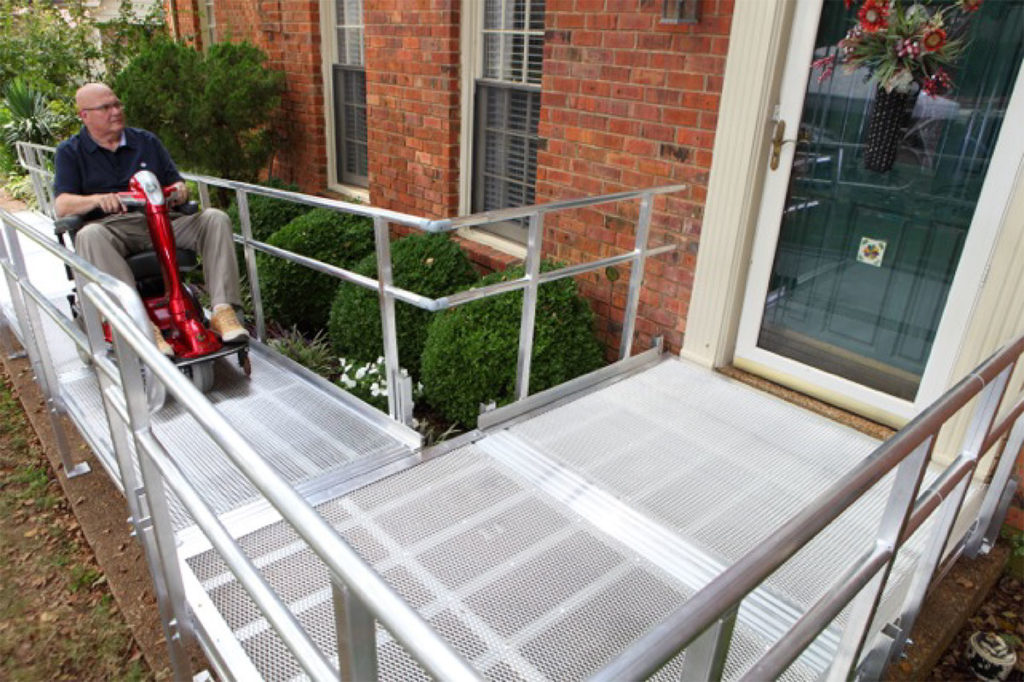
For example, open weave aluminum wheelchair ramps provide ample drainage to avoid buildup of snow, ice, or water. We can install Ascenseurs de porche that operate in extremely cold weather conditions, so you can have peace of mind when you leave the home.
Many customers love our mobility ramp and wheelchair rental program that provides affordable, seasonal access to wheelchairs, ramps, lifts, and other mobility products. All products in our rental line are ADA-compliant and installed by factory-trained experts.
With the right resources, you can live independently at home and have a safe and empowering experience. We hope this article has offered helpful information about staying connected to your support system–virtually and physically.
Remember: if you need help, we’re here for you. Schedule a free in-home consultation by contacting your local accessibility experts at Next Day Access. We will bring the industry’s best knowledge, skills, and products to your front door.
“I was totally amazed and so appreciative of the rapid response, professionalism, and workmanship that was provided. I will be referring Next Day Access to everyone. It was truly a superb experience…getting the ramp was the one thing I was dreading, but of all the work that had to be done Next Day Access made it the best experience of all….thank you so very much!!!”
Constance, Tennessee





